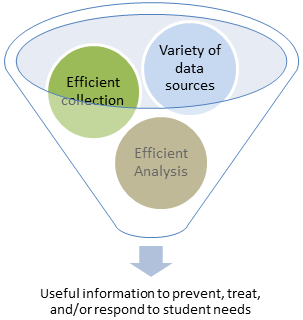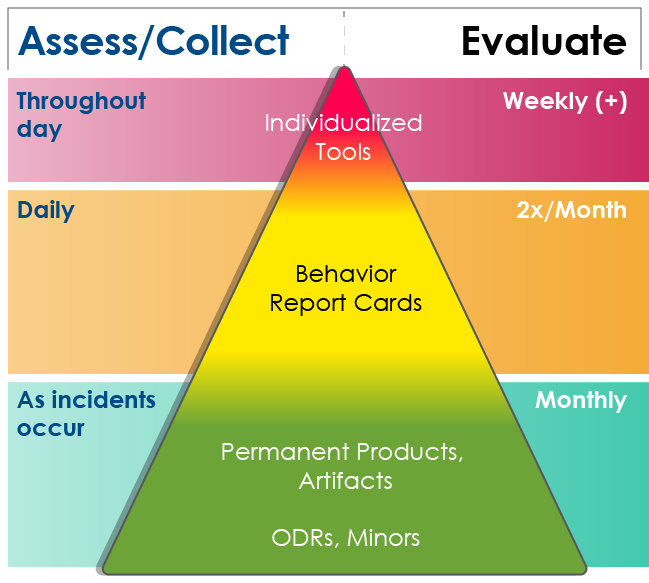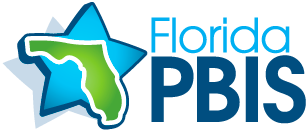Foundations for Implementation
Effective Data Systems for Behavior
A Multi-Tiered System of Support uses a data-based problem solving process to make decisions about support provision in schools. This requires a data system that makes it easy to answer questions that come up during the problem-solving process.
Data Sources

Data sources should:
DEFINE Help you to identify students' needs in relation to established goals
ANALYZE Help you to understand the barriers to students' reaching their goals
IMPLEMENT Provide sufficient info to select, match, and deliver services/supports to students
EVALUATE Contribute to evaluating the effectiveness of services and supports provided to students
Displaying Data
At each tier, the frequency of data collection and evaluation should match the intensity of the supports provided to students. The way that data are displayed and used will vary depending on the specific questions that are being asked. Data systems must be flexible enough so that teams may combine and disaggregate their information as needed to problem-solve effectively.

| Characteristics | Using Data: Guiding Questions |
|---|---|
Frequency and variety of assessments for monitoring progress should be matched to the intensity of the student’s needs
|
Are the majority of students receiving intensive intervention making adequate progress?
|
| Answer the questions necessary to identify effective strategies for significant learning challenges or barriers |
Are students who are progressing at Tier 3 also demonstrating progress towards the Tier 1 expectations? |
Data provide meaningful information about instructional effectiveness and student progress towards developmental and grade-level expectations |
| Characteristics | Using Data: Guiding Questions |
|---|---|
Assessment tools are easy and efficient for all staff members to complete |
What are the similar instructional, behavioral, social, and/or life skill needs among our students? |
Varied for different student needs, but are always aligned to the Tier 1 expectations |
Which small-group evidence-based interventions will meet those needs? |
The frequency of assessment matches the level of student need (e.g., throughout the day, daily, weekly, etc.)
|
Are the majority of students receiving a supplemental intervention making adequate progress?
|
| Data provide meaningful information about instructional effectiveness and student progress |
Are students who are progressing at Tier 2 also demonstrating progress towards the Tier 1 expectations? |
| Characteristics | Using Data: Guiding Questions |
|---|---|
Regular data collection allows educators to monitor the progress of all students |
What do we expect our students to know, understand, and do as a result of instruction? |
|
Data are used to guide instruction and lesson plans (formative assessment) |
Do at least 80% of our students meet or exceed these expected levels?
|
Data are used to evaluate effectiveness of Tier 1 instruction and supports (summative assessment – e.g., end-of -year PBSES evaluations) |
What barriers have prevented students from reaching the expected levels? |
Answer specific questions to guide effective problem solving |
How will fidelity of support be monitored over time? |
Inform evidence-based instructional practices and progress towards meeting school-wide or district-wide standards |
Additional Reading
-
Download a summary of effective data systems.
-
Do you have an effective data system for behavior at Tier 1? Find out
Curious about what an effective data system for behavior might look like? Try the RtIB Demo Database.
-
Learn more about the Tier 1 Critical Element: Data Entry and Analysis Plan
